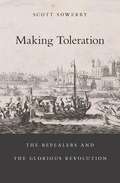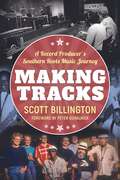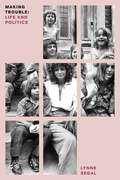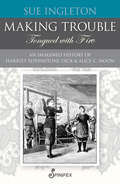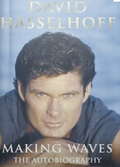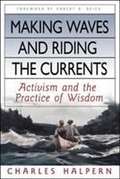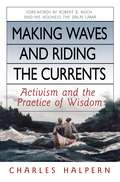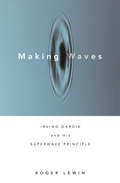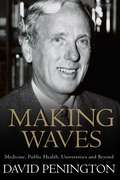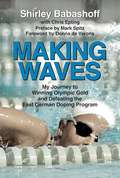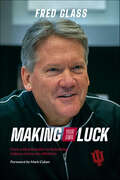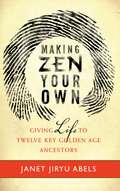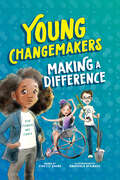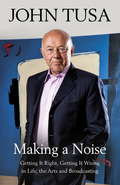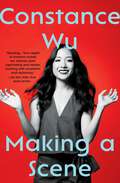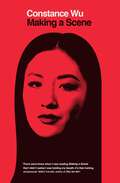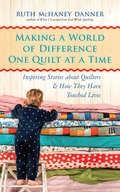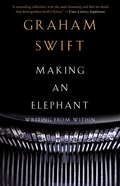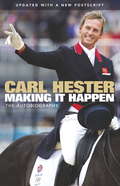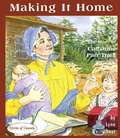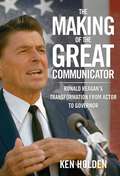- Table View
- List View
Making Toleration: The Repealers and the Glorious Revolution
by Scott SowerbyIn the reign of James II, minority groups from across the religious spectrum, led by the Quaker William Penn, rallied together under the Catholic King James in an effort to bring religious toleration to England. Known as repealers, these reformers aimed to convince Parliament to repeal laws that penalized worshippers who failed to conform to the doctrines of the Church of England. Although the movement was destroyed by the Glorious Revolution, it profoundly influenced the post-revolutionary settlement, helping to develop the ideals of tolerance that would define the European Enlightenment. Based on a rich array of newly discovered archival sources, Scott Sowerby’s groundbreaking history rescues the repealers from undeserved obscurity, telling the forgotten story of men and women who stood up for their beliefs at a formative moment in British history. By restoring the repealer movement to its rightful prominence, Making Toleration also overturns traditional interpretations of King James II’s reign and the origins of the Glorious Revolution. Though often depicted as a despot who sought to impose his own Catholic faith on a Protestant people, James is revealed as a man ahead of his time, a king who pressed for religious toleration at the expense of his throne. The Glorious Revolution, Sowerby finds, was not primarily a crisis provoked by political repression. It was, in fact, a conservative counter-revolution against the movement for enlightened reform that James himself encouraged and sustained.
Making Tootsie: A Film Study with Dustin Hoffman and Sydney Pollack (Shooting Script)
by Susan Dworkin“A perceptive and provocative work.”—Los Angeles Times“A stunning job of research, observation and reporting.”—Larry Gelbart, co-writer of Tootsie and writer on TV’s “M*A*S*H*”“This fluid, marvelously detailed book goes a long way toward explaining why Tootsie has already achieved a reputation as a classic film comedy.” —PeopleMaking Tootsie is back, three decades after the creation of the blockbuster Hollywood motion picture that the American Film Institute rated as #2 on its list of the 100 Best Comedies of All Time (second only to Some Like it Hot). Playwright, author, and Ms. magazine contributing writer Susan Dworkin was granted unprecedented access to the film set, the cast, and the crew during the filming and through post-production of the 1982 classic, and her riveting, detailed chronicle offers a fascinating window into the art of movie making—as well as painting indelible portraits of the two main men who made Tootsie happen: director Sidney Pollack and star Dustin Hoffman. No movie buff, film historian, student, or fan will want to miss Making Tootsie.
Making Tracks: A Record Producer’s Southern Roots Music Journey (American Made Music Series)
by Scott BillingtonFrom the 1980s through the early 2000s, a golden era for southern roots music, producer and three-time Grammy winner Scott Billington recorded many of the period’s most iconic artists. Working primarily in Louisiana for Boston-based Rounder Records, Billington produced such giants as Irma Thomas, Charlie Rich, Buckwheat Zydeco, Johnny Adams, Bobby Rush, Ruth Brown, Beau Jocque, and Solomon Burke. The loving and sometimes irreverent profiles in Making Tracks reveal the triumphs and frustrations of the recording process, and that obsessive quest to capture a transcendent performance. Billington's long working relationships with the artists give him perspective to present them in their complexity—foibles, failures, and fabled feats—while providing a vivid look at the environs in which their music thrived. He tells about Boozoo Chavis’s early days as a musician, jockey, and bartender at his mother’s quarter horse track, and Ruth Brown’s reign as the most popular star in rhythm and blues, when the challenge of traveling on the “chitlin’ circuit” proved the antithesis of the glamour she exuded on stage. In addition, Making Tracks provides a widely accessible study in the craft of recording. Details about the technology and psychology behind the sessions abound. Billington demonstrates varying ways of achieving the mutual goal of a great record. He also introduces the supporting cast of songwriters, musicians, and engineers crucial to the magic in each recording session. Making Tracks sings unforgettably like a "from the vault" discovery.
Making Trouble
by Lynne SegalWhat happens when angry young rebels become wary older women, ageing in a leaner, meaner time: a time which exalts only the ‘new’, in a ruling orthodoxy daily disparaging all it portrays as the ‘old’? Delving into her own life and those of others who left their mark on it, Lynne Segal tracks through time to consider her generation of female dreamers, what formed them, how they left their mark on the world, where they are now in times when pessimism seems never far from what remains of public life. Searching for answers, she studies her family history, sexual awakening, ethnic belonging, as well as the peculiarities of the time and place that shaped her own political journeys, with all their urgency, significance, pleasures and absurdities.From the Trade Paperback edition.
Making Trouble (Tongued with Fire): An Imagined History of Harriet Elphinstone Dick and Alice C Moon
by Sue IngletonIn the winter of 1875, two rebellious spirits travel from England to Australia. Harriet Rowell (age 22) and Alice Moon (age 18) were champion swimmers in a time when women didn't go into the sea; and they were in love in a time when many women were in love with each other but held such love secretly. Harriet and Alice took on the world at a dangerous time for women's freedom of expression, but their love ended when Alice moved to Sydney to become a writer. Before Harriet can get over her grief from the breakup, tragedy strikes; Alice is found dead in her bed at thirty-seven. Suspicions rest upon the powerful, chauvinistic scientist, John McGarvie Smith, with whom Alice had been working in her newfound capacity as a journalist. This book seeks to uncover the truth of Alice's death and seek justice.
Making Waves
by Catherine J ToddMaking Waves follows Hasselhoff’s acting career from his early childhood role in Peter Pan to his highly acclaimed performance in Chicago in London’s West End, and his new TV triumph in Simon Cowell’s America’s Got Talent. The wealth of inside information includes untold stories of his first marriage and his life as a TV star in Knight Rider and Baywatch. At times deeply personal, it also reveals his fight against drink that nearly drove him to destruction and the devastating motorbike accident in which his second wife Pamela was badly injured. The conclusion covers the reasons for the breakdown of their marriage. Described as a ‘living legend’, this fascinating book gives a new and moving insight into what it means to be the most watched TV star in the world.
Making Waves
by David HasselhoffMaking Waves follows Hasselhoff?s acting career from his early childhood role in Peter Pan to his highly acclaimed performance in Chicago in London?s West End, and his new TV triumph in Simon Cowell?s America?s Got Talent. The wealth of inside information includes untold stories of his first marriage and his life as a TV star in Knight Rider and Baywatch. At times deeply personal, it also reveals his fight against drink that nearly drove him to destruction and the devastating motorbike accident in which his second wife Pamela was badly injured. The conclusion covers the reasons for the breakdown of their marriage. Described as a `living legend?, this fascinating book gives a new and moving insight into what it means to be the most watched TV star in the world.
Making Waves and Riding the Currents: Activism and the Practice of Wisdom
by Charles HalpernThis memoir is about working for a compassionate and sustainable world. This teaches how to integrate the inner and outer work of one's lives through the practice of wisdom.
Making Waves and Riding the Currents: Activism and the Practice of Wisdom
by Charles HalpernThis book is about working for a more just, compassionate, and sustainable world while cultivating the wisdom that supports and deepens this work. Charles Halpern is a social entrepreneur with a remarkable record of institutional innovation. He founded the Center for Law and Social Policy, the nation’s first public interest law firm, litigating landmark environmental protection and constitutional rights cases. As founding dean of the new City University of New York School of Law he initiated a bold program for training public interest lawyers as whole people. Later, as president of the $400 million Nathan Cummings Foundation, he launched an innovative grant program that drew together social justice advocacy with meditation and spiritual inquiry. In his years of activism, he had a growing intuition that something was missing, and he sought ways of developing inner resources that complemented his cognitive and adversarial skills. These explorations led him to the conviction that what he calls the practice of wisdom is essential to his effectiveness and well-being and to our collective capacity to address the challenges of the 21st century successfully. With wit and self-deprecating humor, Halpern shares candid and revealing lessons from every stage of his life, describing his journey and the teachers and colleagues he encountered on the way—a cast of characters that includes Barney Frank and Ralph Nader, Ram Dass and the Dalai Lama. Making Waves and Riding the Currents vividly demonstrates the life-enhancing benefits of integrating a commitment to social justice with the cultivation of wisdom. It is a real-world guide to effectively achieving social and institutional change while maintaining balance, compassion, and hope.
Making Waves: Irving Dardik and His Superwave Principle
by Roger LewinThe biography of a medical maverick who is challenging scientific convention with his astounding approach to achieving and maintaining health.Dr. Irving Dardik's radical notions about how all matter moves in interconnected waves has drawn deep skepticism from physicists, and his early attempts to put his theory into practice in the field of health care got him banned from practicing medicine in the 1990s. But now, after a decade's worth of rigorous research that seems to support Dardik's SuperWave theory, scientists at such esteemed institutions as MIT, Harvard, and Stanford Research International are signing on with Dardik's team to probe the possibilities. For example, Dardik's unique approach to physical exercise, based on his Principle, has achieved some remarkable successes in reversing symptoms of chronic disease.Making Waves weaves together two fascinating stories: Dardik's personal progression from vascular surgeon to scientific iconoclast and pioneer, chronicling his struggle to convince the scientific community to take him seriously; and the evolution of his mind-expanding SuperWave Principle. Colleagues--skeptics as well as supporters--consider the impact of SuperWave theory on current thinking about nature on all scales, from the universe to the subatomic world, and in the realms of biology, applied science, and medicine. The resulting read will interest those concerned with their own health and vitality as well as those curious about the fundamental workings of nature.
Making Waves: Medicine, Public Health, Universities and Beyond
by David PeningtonThroughout his academic and medical careers, David Penington has been an agent of change. In his fascinating memoirs, one of Australia's leading public health experts and the former Vice Chancellor of the University of Melbourne reveals his ethos, drives and the highs and lows of a life built on making waves. Appointed at St Vincent's Hospital in Melbourne, he fostered new medical research specialty areas in haematology, medical oncology, endocrinology, gastroenterology and later neurology, and renal disease--a strategic development for a public hospital in the early 1970s. At the University of Melbourne, he was Professor and then Dean of the Faculty of Medicine, before becoming Vice Chancellor in 1988. During his tenure, he strongly resisted major and damaging government intrusion into the operations of universities, all the while reforming the education, research and management practices at the University of Melbourne. He has been at the forefront of national public health policy for more than twenty years, including four years chairing the National AIDS Task Force for the Hawke government. In 1984 he was Chair of the National Committee of Inquiry into a dispute between the government and the medical profession over public hospitals, which was key to the implementation of the Medicare system. He has also led two inquiries into illicit drug policies. Making Waves details a tireless leader who at every stage of his working life has never shunned public controversy in a bid to improve the lives of all Australians.
Making Waves: My Journey to Winning Olympic Gold and Defeating the East German Doping Program
by Chris Epting Shirley Babashoff<p>In her extraordinary swimming career, Shirley Babashoff set thirty-nine national records and eleven world records. Prior to the 1990s, she was the most successful U.S. female Olympian and, in her prime, was widely considered to be the greatest female swimmer in the world. <p>Heading into the 1976 Olympic Games in Montreal, Babashoff was pictured on the cover of Sports Illustrated and followed closely by the media. Hopes were high that she would become “the female Mark Spitz.” <p>All of that changed once Babashoff questioned the shocking masculinity of the swimmers on the East German women’s team. Once celebrated as America’s golden girl, Babashoff was accused of poor sportsmanship and vilified by the press with a new nickname: “Surly Shirley.” <p>Making Waves displays the remarkable strength and resilience that made Babashoff such a dynamic champion. From her difficult childhood and beginnings as a determined young athlete growing up in Southern California in the 1960s, through her triumphs as the greatest female amateur swimmer in the world, Babashoff tells her story in the same unflinching manner that made her both the most dominant female swimmer of her time and one of the most controversial athletes in Olympic history.</p>
Making Your Own Luck: From a Skid Row Bar to Rebuilding Indiana University Athletics
by Fred GlassOne man's odyssey from skid row to rebuilding a major collegiate sports program. In Making Your Own Luck, former Indiana University athletic director Fred Glass recounts how even a self-described "knucklehead" learned to be prepared to recognize and seize opportunities and thus make his own luck through life. Growing up in a skid row bar, having an alcoholic father, struggling with anxiety and self-doubt, and making his share of stupid mistakes, Glass had much to contend with in early life. However, supported by socially enlightened parents, a Jesuit education, and his soulmate, Barbara, his odyssey has led him to serve a mayor, a governor, a senator, and even a president. With great humor and insightful reflection, Glass details how he helped keep the Colts in Indianapolis—he spearheaded a massive convention center expansion and the building of Lucas Oil Stadium and even helped to attract the Super Bowl to his hometown. Any of these accomplishments individually would be more than enough to call Glass's career a resounding success, but they were only the beginning. In the latest stage of his journey, Glass led the rebuilding of the athletic program of his beloved alma mater, Indiana University. Featuring a foreword from IU alumnus and owner of the Dallas Mavericks, Mark Cuban, Making Your Own Luck is a must-read not only for Indiana sports fans, but for anyone that recognizes the importance of preparation, opportunity and action in creating your own success.
Making Zen Your Own
by Janet Jiryu AbelsIn this book, Janet Jiryu Abels traces the life stories of twelve Chinese Zen masters who, together, shaped what was to become known as Zen's Golden Age. She presents their biographies, describes their teachings, and shows how their lives and teachings can inspire those who practice Zen today. The book is a presentation of ancient Zen insight vividly relevant for the twenty-first century, addressing both the needs of both new and longtime Zen practitioners. Its singular distinction is in bringing Zen history, ancestral teachings, and present-day application of those teachings into one work. Although the book is based on scholarly sources and historical records, Abels stresses the humanity of these Zen ancestors, showing that they were not formed from a generic mold but were individuals with quirks, senses of humor, heartfelt enlightenment experiences, varied ways of living, and unique ways of expressing Zen. She tells their stories in a lively, accessible manner, shedding light on their paradoxical teachings with clarity and simplicity. She also shows that they all faced the same challenges that Zen practitioners face today. Interwoven among the stories and teachings are Abels' own insights into the dharma of Zen, as well as practical applications and encouragements that readers can bring to their individual practice of the Way. These insights are based on her more than ten years as a Zen teacher. She is the founder and co-resident teacher of Still Mind Zendo in New York City.
Making a Difference (Young Changemakers)
by Stacy C BauerYoung Changemakers is an inspirational series all about real kids from around the globe doing extraordinary things to make a difference in their communities and the world!Making a Difference is filled with stories of kids who are making the world a better place by following their hearts and chasing their dreams. Whether planting a billion trees, bringing joy to others through music, fundraising for sick children or starting an inclusive dance team, these determined youth are using their talents to do amazing things!
Making a Noise: Getting It Right, Getting It Wrong In Life, Arts And Broadcasting
by John TusaIn almost sixty years of professional life, John Tusa has fought for and sometimes against the major arts and political institutions in the country. A distinguished journalist, broadcaster and leader of arts organisations, he has stood up publicly for the independence of the BBC, the need for public funding of the arts and for the integrity of universities. He has made enemies in the process. From the battles to create the ground-breaking Newsnight in 1979, to six years of defending the BBC World Service from political interference, Tusa's account is etched with candour. His account of two years of internecine warfare at the top of the BBC under the Chairman, 'Dukey' Hussey will go down as a major contribution to BBC history. His recollections of a hilarious and petty-minded few months as head of a Cambridge college will be read as a case study of the absurdities of academic life; while running the rejected and maligned Barbican Centre, Tusa led its recovery into the major cultural centre that it is today.Often based on personal diaries, Making a Noise is a fearless and entertaining memoir of life at the top of the arts and broadcasting.
Making a Noise: Getting It Right, Getting It Wrong in Life, Arts and Broadcasting
by Sir John TusaJohn Tusa is a distinguished journalist, broadcaster and leader of arts organisations, best remembered for his times at the BBC, including creating Newsnight.Tusa's memoir is etched with candour. His account of two years of internecine warfare at the top of the BBC under the Chairman, 'Dukey' Hussey will go down as a major contribution to BBC history. His recollections of a hilarious and petty-minded few months as head of a Cambridge college will be read as a case study of the absurdities of academic life; while running the rejected and maligned Barbican Centre, Tusa led its recovery into the major cultural centre that it is today.
Making a Scene
by Constance WuNamed a Most Anticipated Book by Time and Associated Press! From actor Constance Wu, a powerful and poignant memoir-in-essays.Growing up in the friendly suburbs of Richmond, Virginia, Constance Wu was often scolded for having big feelings or strong reactions. &“Good girls don&’t make scenes,&” people warned her. And while she spent most of her childhood suppressing her bold, emotional nature, she found an early outlet in local community theater—it was the one place where big feelings were okay—were good, even. Acting became her refuge, her touchstone, and eventually her vocation. At eighteen she moved to New York, where she&’d spend the next ten years of her life auditioning, waiting tables, and struggling to make rent before her two big breaks: the TV sitcom Fresh Off the Boat and the hit film Crazy Rich Asians. Through raw and relatable essays, Constance shares private memories of childhood, young love and heartbreak, sexual assault and harassment, and how she &“made it&” in Hollywood. Her stories offer a behind-the-scenes look at being Asian American in the entertainment industry and the continuing evolution of her identity and influence in the public eye. Making a Scene is an intimate portrait of pressures and pleasures of existing in today&’s world.
Making a Scene
by Constance WuFrom influential and iconic star Constance Wu, a powerful and poignant memoir-in-essays full of funny and intimate observations that will resonate with readers everywhere.Growing up in the friendly suburbs of Richmond, Virginia, Constance Wu thought that girls were supposed to be reserved, graceful, and polite. Everyone around her praised ladylike behaviour while seeming to disapprove of the louder, rougher girls – the kind of girls who made scenes. And while she spent most of her childhood suppressing her bold, emotional nature, Constance found an early outlet in local community theatre. The stage was the one place where big feelings were okay – were good, even. As she continued to reconcile her personality with the expectations of daily life, acting became more than a hobby. It was her refuge, her touchstone, and eventually her vocation. She went to New York to study classical theatre and pursue an acting career while waiting tables, dating, despairing, and embracing city life. In 2015, she was cast in the ground-breaking TV sitcom Fresh Off the Boat, a touching, funny story about an Asian American family in the &’90s. Another historic role followed when she starred in the smash hit film Crazy Rich Asians, which featured an entirely Asian cast. These two pivotal moments in Hollywood history opened up a new chapter for Constance, who continues to explore the complexities of Asian American representation.Through raw, hilarious, and relatable stories, Constance fearlessly shares her experiences of growing up in suburban Virginia, scraping by as a struggling actress, falling in love again and again, confronting her identity and influence, and navigating the pressures and pleasures of existing in today&’s world.
Making a World of Difference One Quilt at a Time
by Ruth Mchaney DannerQuilts exemplify precious things: comfort through the warmth they provide; community, since they are often created by groups; and love, given the time and effort they require. With this in mind, legions of kindhearted quilters all over the world choose to donate their labors of love to people in need. Ruth McHaney Danner has gathered fifty-four heartwarming stories of quilters who make their compassion tangible one stitch, square, and quilt at a time. Each story introduces a quilter or group of quilters, ranging from a blind woman in Texas to preschoolers in Australia. Their gifts have the power to make recipients feel cherished and supported, even though they may never meet face-to-face. These wonderfully inspiring stories show that every quilter who has ever wondered, "But what can I do?" can do something to reach out and help others.
Making an Elephant: Writing from Within
by Graham Swift‘An immensely readable volume. On every page, Swift emerges as a considerable essayist, who upholds the sterling virtue of good writing combined with emotional and intellectual engagement’Evening StandardAs a novelist, Graham Swift delights in the possibilities of the human voice, imagining his way into the minds and hearts of an extraordinary range of characters. In Making an Elephant, his first ever work of non-fiction, the voice is his own. Swift brings together a richly varied selection of essays, portraits, poetry, and reflections on his life in writing, full of insights into his passions and motivations, and wise about the friends, family, and other writers who have mattered to him over the years. Kazuo Ishiguro advises on how to choose a guitar, Salman Rushdie arrives for Christmas under guard, and Ted Hughes shares the secrets of a Devon river. There are private moments, too, with long-dead writers, as well as musings on history and memory that readers of Swift’s novels will recognize and love. ‘A rewarding collection, with the same humanity and flair for detail that distinguishes Swift’s fiction’TLS‘Revealing, self-deprecating, full of fascinating details. ’Edward Marriott, Observer‘Swift’s essays display the same quiet intensity as his fiction, a capacity for subtle storytelling with dark emotional undercurrents’Financial Times
Making it Happen: The Autobiography
by Carl Hester Bernadette HewittCarl Hester is one of the greatest ever equestrians, leading Great Britain to Gold Medal victory at the London 2012 Olympics. In these vibrant memoirs, he tells the incredible story of the passion for horse-riding which revolutionised his life and made him the champion he is today.Carl grew up on the remote Channel Island of Sark, moving to the UK mainland at the age of 16 to work with horses, mainly as a way to leave home. He could never have predicted what a great affinity he would have for dressage. Carl's career enjoyed a stratospheric rise as he progressed from working as a groom/rider to riding international dressage horses full time for renowned owners Dr and Mrs Bechtolsheimer, to training his own horses, and other top riders, to international success.Carl's early career revealed someone capable of monumental achievements. He provides a rare insight into both the people and the horses that drove him to victory, initially the skewbald mare Jolly Dolly on which he won the 1985 Young Riders Dressage Championship. During the early 1990s he rode in the World Championships, the European Championships and the 1992 Barcelona Olympics, becoming Great Britain's youngest ever rider to compete in the Games. His riding skills have increased with age, culminating in the hugely successful years as part of the Gold Medal teams that won the 2011 European Dressage Championships and, of course, that made history at London 2012. He achieved both feats on the same extraordinary horse, Uthopia, while as a trainer he produced the even more remarkable combination of Charlotte Dujardin and Valegro.A first-class sportsman and a witty and engaging writer, Carl now offers his admirers the opportunity to read an intelligent, humorous and, above all, inspiring account of his life - from the ups and downs of his career to the motivations and techniques which have helped him to win 66 national titles, represent Team GB at four Olympic Games, two World Championships and seven European Championships, and become one of the best riders - and horsemen - in the world.
Making it Happen: The Autobiography
by Carl Hester Bernadette HewittCarl Hester is one of the greatest ever equestrians, leading Great Britain to Gold Medal victory at the London 2012 Olympics. In these vibrant memoirs, he tells the incredible story of the passion for horse-riding which revolutionised his life and made him the champion he is today.Carl grew up on the remote Channel Island of Sark, moving to the UK mainland at the age of 16 to work with horses, mainly as a way to leave home. He could never have predicted what a great affinity he would have for dressage. Carl's career enjoyed a stratospheric rise as he progressed from working as a groom/rider to riding international dressage horses full time for renowned owners Dr and Mrs Bechtolsheimer, to training his own horses, and other top riders, to international success.Carl's early career revealed someone capable of monumental achievements. He provides a rare insight into both the people and the horses that drove him to victory, initially the skewbald mare Jolly Dolly on which he won the 1985 Young Riders Dressage Championship. During the early 1990s he rode in the World Championships, the European Championships and the 1992 Barcelona Olympics, becoming Great Britain's youngest ever rider to compete in the Games. His riding skills have increased with age, culminating in the hugely successful years as part of the Gold Medal teams that won the 2011 European Dressage Championships and, of course, that made history at London 2012. He achieved both feats on the same extraordinary horse, Uthopia, while as a trainer he produced the even more remarkable combination of Charlotte Dujardin and Valegro.A first-class sportsman and a witty and engaging writer, Carl now offers his admirers the opportunity to read an intelligent, humorous and, above all, inspiring account of his life - from the ups and downs of his career to the motivations and techniques which have helped him to win 66 national titles, represent Team GB at four Olympic Games, two World Championships and seven European Championships, and become one of the best riders - and horsemen - in the world.
Making it Home: The Story of Catharine Parr Traill
by Lynn WesterhoutAs a pioneer in Canada in the early 1800s, Catharine Parr Traill was one of the first writers to record the Ontario wilderness in literary and scientific detail, and her stories for young people became part of a new focus on young people. Her books on emigration encouraged other pioneers who struggled with life in a new country. Catharine was a natural storyteller who loved to write. As an adult in Canada, she wrote while she was hungry and fearful for her family’s safety. Her life was one of hardship and adventure, but also of great joy. This biography shows how an English girl called Katie became an adult who gave so much to North America’s early literature.
Making of the Great Communicator: Ronald Reagan's Transformation from Actor to Governor
by Kenneth HoldenOne week after Ronald Reagan announced his candidacy for governor of California, the San Francisco Chronicle gibed: “It was simply a flagrant example of miscasting.” Reagan was tanking, and his businessmen backers panicked. Their bold experiment was about to fail. Then a think-tank friend suggested the expertise of two UCLA social pyschologists. Kenneth Holden and Stanley Plog agreed to take the job only if they could have three full days alone with Reagan. The candidate and his backers agreed, and the three men disappeared into a Malibu beach house. Those three days remade the bumbling neophyte into an articulate, confident politician whose devastating sound bites shredded the opposition. Holden or Plog remained by Reagan’s side for the rest of the campaign, feeding him information about California’s problems, teaching him to handle the press, writing his position papers, and helping develop the programs he offered, all while battling factions of the campaign team who seemed determine to sabotage their own man. Not everyone who voted for Reagan supported his positions, but voters preferred his honesty and forthrightness to the waffling of other politicians. Reagan won by a landslide. Holden and Plog had shaped an actor into a governor, but they were also turning a governor into a president. Here is the untold story of how they did it.
